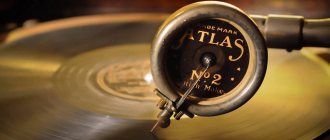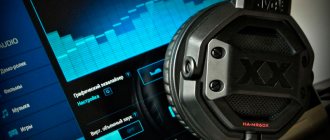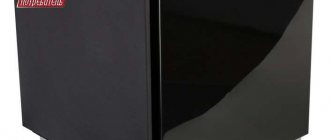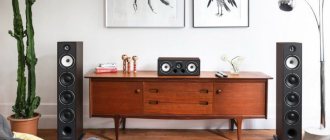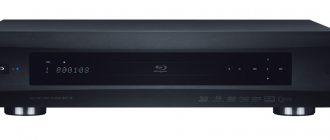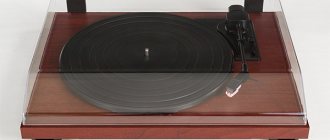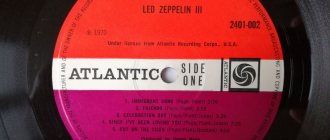One of the best types of sound systems is Hi-End horn acoustics. Despite the high cost, systems of this type provide high sound quality and can satisfy the needs of even the most sophisticated listeners. How to make horn acoustics with your own hands, and according to what drawings can you make it yourself?
Horn acoustics Hi-End
Story
The first horn-type loudspeakers appeared in the 20s of the last century. The equipment was intended to amplify the human voice.
A few years later, systems resembling modern music playback equipment appeared. The technology of horn acoustics was not forgotten, but it was believed that it was not suitable for the home, and it was used only in open spaces.
By the 40s of the last century, the American engineer Paul Klipsch created a completely new design of horn acoustics, and proved that it was capable of reproducing music with very high quality not only in open areas, but also at home.
Paul Klipsch
The system instantly gained popularity among connoisseurs of high-quality sound because of its unique sound, and is still the standard of quality among speaker systems for home and outdoor use.
Reference: after the invention of horn acoustics, the engineer founded a company for the production of acoustic systems, which is a world leader in the modern world. The company name is Klipsch, and horn-type speakers are sometimes called “clipschs.”
Horn type speakers
DIY horn strip
Exactly a year ago, I posted a description of a wooden horn for two-way acoustics. And he talked about 50GDN-37. I thought that everything would be ready. Not so. And so, for the new old... New Year :)))) it has come true. You can see how this happened below. The result was a two-way speaker almost based on Russian speakers - a low-frequency speaker based on the NOEMA 50GDN-37 speaker, widely known in narrow circles of home-made speakers. And the high-frequency horn link on the speakers is less well-known in Russian wide circles... narrow... well, the home-made people understood me, the EVM company.
During this time, the concept of the high-frequency link was completely changed, and the low-frequency link was completely redesigned. Let's start with HF perhaps. Why do you need a horn at home? you ask, but the horn high frequency preserves the sound image (let’s say the original frequency response) without changing in the listening area. And any point source of sound, be it a cone or dome HF, will spread the HF with a spherical front, radiating in all directions in the room. As a result, both direct radiation and all kinds of reflections, re-reflections and resonances of the room reach the listener. The frequency response is the most curved. Controlling the radiation pattern with the horn and waveguide avoids this effect. Why did they abandon this? But it's expensive and cumbersome. The horn was developed mainly for professional sound. There you need a lot of power and range to sound the cinema hall and as a result everyone started moving there. The home theme remained with expensive high-end and no less cheap studio monitors. But there were also voices for quality. Don Keele was the first to describe such a horn link A little later, based on Keele’s work, Clifford A. Henricksen and Mark S. Ureda of Altec introduced the Mantaray horn to the world. link The main task was to create as uniform a sound field as possible over a wide dispersion angle. This was fundamentally different from most professional systems, where range is important, for which they paid for beam directionality.
But almost everything stopped at Montaray. Only Don Kiele himself did not stop, and already working for JBL, he created a whole series of constant directivity horn Biradial horns. For example, JBL 2344 forever captured the image of Dolly Parton in iron... or in plastic, as it turned out))))). An attempt to create approximately such a horn, but for myself, for the house, was the wooden project of Yuichi. Formative hyperbolic. In essence, it is a mouthpiece of constant direction. Hyperboloid engineer Ayuchi))) A-290 FL Hyperbolic Wood Horn. This project was presented here a year ago.
However, this horn also turned out to have problems with transmitting the sound image.
All without a filter. Above in yellow is the frequency response of the Radian 465 speaker, 10 cm from the horn cutoff. From below, yellow is 3 meters on the sofa in the center, green is 30 degrees from the axis, on the same sofa on the edge, that is, a little further, but the constancy of the radiation pattern works - there is no drop in the frequency response at high levels, or almost no. But the area 1200-4000 is so beautiful up close and fails at a distance. It is unpleasant. This is a problem with the horn, apparently matching the cut of the horn and the surrounding space - that is, the transition of the sound wave from the edge of the horn into the space of the room. And the frequency response had to be greatly adjusted to equalize it in the listening area. But it wasn't bad anymore. The sound does not have the sound of an exponential horn with the same driver. Realizing that this is the right direction of movement, we begin to study the materiel. Research in this direction was carried out not only by JBL and TAD, but also by a group of enthusiasts at diyaudio.org (link there is a program in which you can design a constant directivity horn with specified parameters). The result was the STL with the prototype Elleptikon horn. But converting a point STL into a solid body of a soliwork turned out to be a non-trivial task. But patience and work will overcome everyone. In addition, there is akabak, which is a simulator of the operation of horns, a very useful thing and you can get it for training for free. link As a result, our project looks something like this:
These beautiful pictures say that the horn will be smooth and, most importantly, the radiation pattern will be uniform at an angle of up to 60 degrees horizontally. Here we look at the beautiful shape of the horn in solid, draw the flange and make an object.
And from the STL file, first a Solidworks solid object was obtained, then a CNC machine program and vzhuh. Matrix for horn made of high density MDF. Finding a uniform density of MDF was also not easy.
Well, we glue the flange for attaching the driver, drill holes for installation in the horn. Voila. With a slight movement of the arms and legs... over the course of a year... the idea turns, the idea turns into an almost finished structure in a box. However, the wonderful Radian refused to work in this horn - it cannot be loaded with a large, deep horn. And then our torment and tossing began again. Here are five worthy contenders from a dozen (or even two tested) professional drivers. The 475 Radian has a magnet twice that of the 465 and pushes this horn with a bang. The 18sound ND1090 is very good paired with the B&C DE500, but their current price tag is simply killer. Surprisingly, the EVM5245E turned out to be excellent in sound; the only caveat is that you need to carefully select the pairs. And here is the EVM in our ellipticon. This is without filters at all.
Violet is measured at a listening point 3 m from the speakers - in the center on the sofa, approximately 15 degrees from the axis. Green is a displacement to the edge of the sofa, approximately 30 degrees from the axis and a little further from the source, 3.5 meters in a straight line. The speaker is almost level with the wall, that is, 15 degrees from the axis, the first measurement (I did not take the axis). But 1500-16000 transmits one to one. We check the simulation of the behavior of the horn in AKABAK 2 (in the third version there is incompatibility of data transfer from ATX 4.7, or vice versa)))) and we are surprised how everything corresponds. Then everything is also simple - using the excellent free vituixcad kimmosaunisto.net/ we simulate a filter for the resulting horn. Here's an example, exactly with a section of approximately 1100. Well, finishing with a file is already in the hardware. Although, it should be noted in the room, and the filter does not work well for auditory preferences. But subjective preference is something completely different.
But then the tuning begins by ear and the crossover frequency and the order of filters and parts in the filter... this is still about six months. But this is a completely different story that can last forever. Well, the woofer here is also arrogant and we’ll talk about it separately.
This is a variant of a comrade - an accomplice in a rehearsal point of 60 sq.m.
Of course, I will also finish the appearance, but for now it was important to make the sound and in the process of setting up filters with microphones and chipboards, my appearance seems apocalyptic. If anyone suddenly))) read to this point, happiness to you in the new year!!! And now about the low-frequency section. A long search led to a very good NOEMA 50GDN-37. All this was installed in a 140 liter box with an onken-like FI. That is, the width of the port was approximately equal to the area of the radiating surface of the diffuser, and the depth was adjusted to the tuning frequency. The result was bass within 40 hertz, colossal pressure and classic FISH sound. Which is what I didn't like. FI pumps up my 16 sq.m. little room and everything is humming like a car. And taking into account the inertia of the FI, the bass was fat and heavy. I don't like this kind of bass at all. And the ZY bass is fast, sharp, but compressed and lightweight with such a mass of the moving system. This is a double-edged sword - if you want good midbass, give a light diffuser and high sensitivity (strong motor), but if you want low bass - give a low resonant frequency and heavy movement... then goodbye fast and detailed midbass. In general, the study of mainly Japanese experience in building high-quality two-way studio monitors from the golden age of audio led to very interesting speakers: TAD 1102 and Coral 12L
linklink It was on these speakers that they made their masterpieces in Japan and positioned them as studio monitors. They all had approximately the same parameters. The mass of the moving system is around 40 grams, the resonant frequency is around 30 hertz and a powerful magnetic system and sensitivity is around 95 dB per watt. For such systems, the MMS/BL ratio, which is the motor power per unit mass of the moving system, will be very good. And the total quality factor in the region of 0.3 allows you to use half the equivalent volume and highly efficient low-frequency design, be it a horn or FI, without fear of exceeding the total quality factor of the system above 1. The 50GDN-37 turned out to be an extremely successful speaker. It plays great up to 2500Hz and the magnetic system is more powerful than the BIG, but as always something is missing. Everything sounds great by ear. Very close in transmission to Telefunken, although the tele can be much higher. The voice is transmitted wonderfully. But down below everything is not so rosy. We need the same one... but with mother-of-pearl buttons... or rather, with a much stronger magnetic system. And secondly, I don’t like the 50GDN-37 centering washer. For a soft suspension you need a soft cloth and small waves of central wool. But here the waves are high and, with a strong amplitude, do not stretch evenly when displaced; the first wave can turn out with a click. With time and amplitude, the cloth may soften and the centering washer will sag... the coil will click against the magnetic system. The ideal solution here would be to return to the textolite spider. It is very soft when moving up and down the axis as the reel moves, but at the same time very rigid and stable when trying to move the reel off-axis to the right or to the left. Moreover, if the box-shaped (well, rag molded with corrugations like the NOEM) centering washer is stretched, then as the amplitude increases, the rigidity will increase. Nothing good either. Coral and TAD have small waves and the rag is most likely not calico. Well, tremble Grigory Trofimovich!!! We are going. (this is the chief designer of NOEMA, if anyone doesn’t know))) After a short refusal of the workshop workers from NOEMA, they surrendered under the powerful onslaught of self-propellers with the support of the chief designer and after “yes, do it - these will not lag behind, I know them” from the head of NOEMA, sighing done.
What was changed: Bleached sulphate pulp, Ts1, was ordered from the pulp and paper mill, 3 kg, begging the managers who wanted to sell the car. Centering washer = textolite crab, the width of the ears was selected the third time. The height of the coil has been increased, the linear displacement is now +-6 = 12mm. The height of the top flange has been increased by 1mm. The magnet is 160mm, the induction in the gap is 1.3 tesla, the MC iron is in saturation, it does not go any further. Till-small parameters: Fs=31hz Qts=0.26 BL=14.4 Ve=241 l Spl = 96db/1wt/1m Mms= 40g Subjectively – the speaker plays easier and more detailed mid and middle than the Coral 12L-44. The result was excellent midbass. Experienced filtering 2nd order at 1400Hz. If you think that it's all over - nooo, now comes the fun part))) How to get bass from a speaker with Qts=0.26 without using a hugely long horn. Further description may hurt the religious feelings of believers from the ZY sect, adherents from the clan of lizards (well, screen-writers and open-minded people) and will certainly hurt the hearts of canonical resonators (ChV, TQWT and others like them). May these companions and followers forgive me. I will immediately disown all kinds of designs of TL, TQWT, horns cut to a quarter wave, folded and other comb resonators. I myself was a follower of the TQWT clan about 15 years ago, having played and listened to it a lot more. Screens, H frames and other 18-inch esoterics are also aside. “Well, it’s almost a bass and it suits me that way” doesn’t appeal to me. I listened to the best bass from an ekranoplan from magnepans. But still the lowest bass is not there. It seems that there is not much left, but it was with the writing about Helmholtz (in common parlance FI) that the pampering with NOEMA and BEAG began. Two such FI males, 160mm in diameter and enormous height, filled a room of 34 sq.m. simply overwhelming it with smeared and pumped-up bass. It’s difficult to describe technically, but FI if it’s quiet, there’s not enough of it, but as soon as a certain level of pressure is exceeded and the room starts up, it becomes unbearably greasy and smeared and drawn out a lot. The GVZ is not a GVZ, but it is difficult not to notice that with the influx of mass the agility of the bass part is lost. When these monsters came into my 16 square hall... I realized that FI in the classical sense is not my thing. After several exotic experiments with the H frame and ZY, we remembered and implemented the good old idea of PAS or variovent. A panel with a speaker is attached in front, and in the back, in a hole for a 15-inch speaker))), a PAS panel is made of two 8mm plywood panels with a bunch of holes (80% of the area of a 12-inch woofer, it seems) and two layers of stretched layers of batting are sandwiched between them. The impedance peak turns out to be one, stretched and strongly compressed from below. There is no photo of the PAS impedance left.
This design requires a very powerful magnetic system. But the sound character of the PAS is very good. There is no laxity of the low frequencies, and no tightness of the low frequencies. And a second wind appeared. PAS really works, the bass sound is a little lacking, but the direction is right. We begin to study the hardware and find an interesting solution. The first prototype box of the “ring FI” can be seen as a stand under the PAS box from above - the front plate with the woofer is attached with 4 bolts to the front panel through a set of washers. The thickness (height) of the slot was adjusted using washers. As soon as they named this ring bass reflex, they just didn’t talk about its physics and operating principle. And orthogonal defects of sound in gases and monopoles... even some people tried to reinvent the wheel, that is, make a patent for themselves for such a solution. But the essence turned out to be extremely interesting. Due to the strong relationship between the oscillating (attached) air to the moving system and the air in the FI, we essentially have an effective, frequency-dependent passive acoustic resistance “hanging” on the moving system at a resonant frequency (and the slot can be adjusted in this way by increasing or decreasing the height) , significantly increasing the mechanical quality factor of the system at this frequency (near the LF resonant frequency) and having virtually no effect on the moving system in the rest of the range. The gap is very narrow and due to air friction against the walls in the gap, the mechanical quality factor of the system increases. (In the classic pass, the quality factor increases due to cotton filling of the holes). On the one hand, due to these same losses, FI pumps almost nothing into the room. (well, a little, of course, it gives in). On the other hand, like any Helmholtz resonator, it dampens this most mobile system at its resonant frequency. All this is customizable. The only thing is that the speaker must have a very powerful magnetic system so that the total quality factor with a speaker of 0.3 comes to 0.707 or so. And if you take a speaker with a full quality factor of 0.45 and half the equivalent volume, then this option will not work - the total quality factor will be under 1 or even higher, at the low-frequency hump and buzzer (which was originally the case with the serial 50DN-37). Thus, it turns out theoretically that this high-quality mass “tied” to the moving system pulls it down at the resonant frequency, like any FI, but at the same time, without tightening anything in the sound. Well, almost everything is visible in the measurements. If our speaker with a resonant frequency of 30 Hz, equivalent to a volume of 240 liters, is placed in a 150 liter box, then the lows will remain from 70-80 hertz.
If in FI, then there will be 30-40 hertz with an excess of meaty and fat bass. In our case, it turns out 35-40 hertz at a level of -3dB, but without puffs and excess low frequencies that push through small rooms. And this is what the frequency response of a system with a standard 50GDN-37 looks like. This is opposite the 50GDN-37 speaker from the listening position - 3.5 meters from the speakers without filters.
The magnetic system of the 50GDN-37 is rather weak - a hump at the lower limit. The total quality factor is off the charts. That's why they made a magnet for 160. Now there is no hump. Here is a new one in design, there are two layers of carpets on the floor, measuring 2 meters with a tail, approximately 15 degrees from the axis. The width of the speaker body is about 45 cm. The baffle step feels great. You can already feel reflections from the walls, but not catastrophically. And after 2k the direction is already obvious. Due to the new cellulose, the diffuser has become stiffer with the same mass and the frequency response has improved slightly.
Well, for comparison, Telefunken Red nipple is half a meter away.)))) it really plays beautifully from 70Hz to 8 kilohertz.
Here is the acoustics fully assembled. The slotted PAS/FI ports can be seen by the unmasking wire leads on the side of the front panel)))
We left behind the scenes about the shmilter filter, but there is almost nothing interesting there, if not the number of auditions, sorted out details... and the choice of crossover frequency... but that is also its own story. And if there were 600 thousand extra, I would buy a JBL M2 and not have to suffer and the listening room would be even 50 square meters... Oh, okay... I was daydreaming. And good luck to everyone in the new year. And don’t let the branch of homemade muska dry up)))
Design
The design of Hi-End class speakers is based on the principle of horn voice amplification, but unlike conventional voice amplifiers, horn systems have high quality reproduction, and the horns are made of special materials, which allows achieving maximum acoustic effects.
Horn Column Design
Audio systems are designed mainly for medium and high frequencies. The reproduction of low frequencies directly depends on the size of the speakers. This means that the lower the frequencies, the larger the speakers should be. There are models with an installed low-frequency resonator, but the cost of the system can increase significantly due to additional components. It is allowed to use a separately connected subwoofer to reproduce low frequencies.
Attention: when connecting additional components, they must be placed in a special housing.
Sheet "TQWP Corpus"
Here the author offers the simplest version of the TQWP drawing. The design allows for the installation of an RF head. Since the dimensions of the case are quite impressive, it is advisable to use a material at least 20–25 mm thick.
The front panel consists of two elements: the main panel, on which the broadband speaker is attached, and a decorative panel, which is glued and secured with self-tapping screws to the main panel. The wideband speaker is installed into the housing from the outside, flush, with an overlapping treble.
In order to give greater rigidity, the bottom panel is also made in the form of a sandwich. To give it a respectable look, two grills are offered, the upper one covering the speakers and the lower one covering the port hole.
Rice. 3. Sheet “TQWP body”
Brief description of the input data.
Front Panel : Material thickness of the main front panel.
Front decorative panel : thickness of the decorative front panel material.
Back panel : Thickness of the back panel material.
Side Panel : Thickness of the side panel material.
Baffle 1 : thickness of the material of the inner baffle 1. To avoid resonance, it is advisable to use a material as thick as possible. The partition is also an element for fastening the side panels and a stiffening rib.
Baffle 2 : Thickness of material at the bottom of the closed end of the horn.
Top panel : thickness of the top panel material.
Bottom panel 1 : material thickness of the bottom trim panel. It is advisable to use the material as thick as possible, since the panel is an element for fastening the side and rear panels.
Bottom panel 2 : material thickness of the bottom panel.
Upper grill : thickness of the material of the decorative cover on the speaker.
Bottom grill : The thickness of the material of the decorative panel covering the port opening. Equal to the thickness of the decorative front panel.
Terminal height : If a rectangular terminal is to be used. If the terminal is of a different shape or is missing, leave the cell empty.
Terminal Width : If a rectangular terminal is to be used. If the terminal is of a different shape or is missing, leave the cell blank.
Terminal Diameter : If a round terminal is to be used. If the terminal is of a different shape or is missing, leave the cell blank.
Speaker Distance : Distance between speaker cabinets. When using a tweeter.
Bottom edge of top grill : The distance between the speaker hole and the bottom edge of the grill.
Lower grill mounting area : An area on the main front panel not covered by a decorative front panel, intended for lower grill fastening elements.
Bevel on the front decorative panel : This parameter is optional.
Grill cloth thickness : Necessary for correct calculation of the lower grill.
Kinds
There are a huge number of subtypes of Hi-End acoustics designed for a wide variety of conditions:
- concert;
- automobile;
- home;
- for open areas;
- and etc.
The market offer allows each person to choose exactly what he needs.
The range of acoustics is very wide
Comparison
When choosing between traditional and horn acoustics, many people have a question - which is better? There is no clear answer to this question, and the debate will always continue. Each audio system has its pros and cons.
In Hi-End systems, the positive points are as follows:
- high sound quality;
- presence effect during playback;
- “transfer of emotions” of the performer;
But horn systems also have disadvantages:
- high price;
- take up a lot of space during installation;
- complex design (it is possible to assemble Hi-End horn acoustics with your own hands, but knowledge of physical and geometric laws is required).
It is impossible to clearly choose between Hi-End and Hi-Fi systems, so everyone chooses for themselves what suits them best.
You need to remember that it is possible to install additional acoustic components, which include point speakers, tweeters and other subtypes of equipment that can improve the sound during playback.
